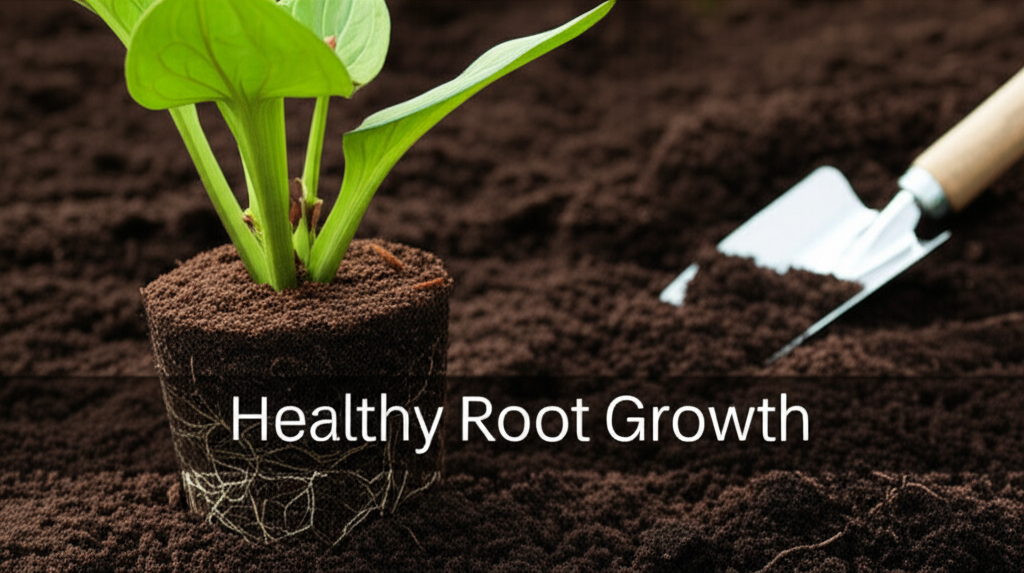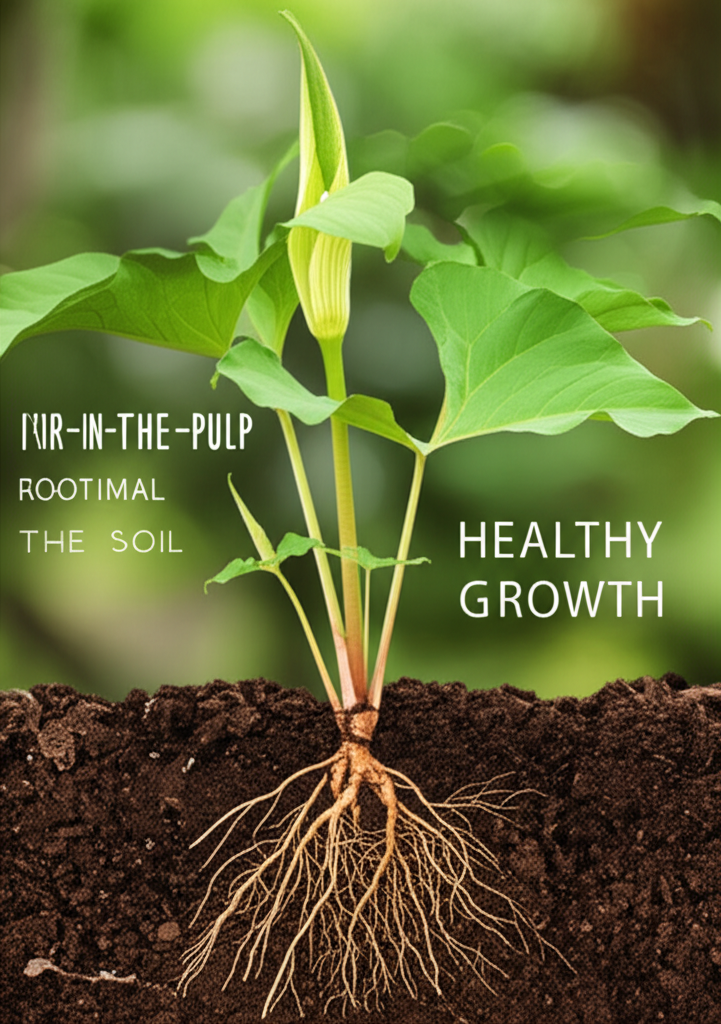The Foundation of a Flourishing Jack-in-the-Pulpit: Understanding Soil Needs
The Jack-in-the-Pulpit (Arisaema triphyllum) is a captivating native woodland perennial that adds a unique architectural element and intriguing bloom to shady gardens. Its distinctive spathe and spadix, resembling a preacher in a pulpit, are a marvel of botanical design. However, to truly encourage robust growth and a healthy root system, understanding and enriching the soil it calls home is paramount. This plant, a denizen of moist, shaded woodlands, has specific requirements that, when met, lead to vigorous underground development, the bedrock of its above-ground beauty.
Why Soil Enrichment is Crucial for Jack-in-the-Pulpit Roots
The subterranean life of a Jack-in-the-Pulpit is as vital as its above-ground presence. Its root system, composed of a corm and fibrous roots, is responsible for anchoring the plant, absorbing water and nutrients, and storing energy for overwintering and the subsequent spring emergence. In its natural habitat, the forest floor provides a rich, loamy environment that is constantly replenished by decaying organic matter. Replicating these conditions in a garden setting is key to unlocking the plant’s full potential.
Neglecting soil enrichment can lead to several detrimental outcomes:
- Stunted Root Growth: Poor soil structure, lack of nutrients, and improper drainage can all inhibit the development of a strong root system.
- Increased Susceptibility to Pests and Diseases: Weakened plants are more vulnerable to fungal infections, nematodes, and other soil-borne issues.
- Reduced Flowering and Fruiting: A compromised root system will struggle to supply the energy needed for producing the plant’s characteristic blooms and the attractive red berries.
- Poor Water Retention: Inadequate organic matter can lead to soil that dries out too quickly, stressing the plant.
- Nutrient Deficiencies: Without readily available nutrients, the plant will show signs of stress, such as yellowing leaves or slow growth.
Therefore, actively enriching the soil is not just beneficial; it’s a fundamental aspect of successful Jack-in-the-Pulpit cultivation.
Ideal Soil Conditions for Jack-in-the-Pulpit

To foster optimal root growth, Jack-in-the-Pulpit thrives in conditions that mimic its native woodland environment. This generally translates to soil that is:
- Rich in Organic Matter: This is arguably the most critical factor. Decomposed leaves, compost, and aged manure provide essential nutrients, improve soil structure, and enhance water retention.
- Moist but Well-Drained: Jack-in-the-Pulpit prefers consistently moist soil, but it cannot tolerate waterlogged conditions. Poor drainage can lead to corm rot.
- Slightly Acidic to Neutral pH: A pH range of 5.5 to 7.0 is generally ideal for this plant.
- Loose and Friable: Compacted soil restricts root penetration and aeration, hindering growth.
Key Soil Components and Their Roles
Understanding the individual components that contribute to ideal soil for Jack-in-the-Pulpit can help in making informed decisions about enrichment:
| Component | Role in Root Growth | Benefits |
|---|---|---|
| Organic Matter (Compost, Leaf Mold) | Provides slow-release nutrients, improves soil structure, enhances water retention, promotes beneficial microbial activity. | Encourages deeper root penetration, increases resilience to drought and disease, fosters a healthy soil ecosystem. |
| Loam (Clay, Silt, Sand) | Provides a balanced foundation for nutrient and water availability, supports root anchorage. | A good loam mixture offers a balance of drainage and moisture retention, crucial for preventing corm rot. |
| Sphagnum Peat Moss | Increases acidity, improves water retention, and adds organic matter. | Beneficial in soils that tend to be alkaline or dry out too quickly, though its sustainability is a consideration. |
| Perlite or Vermiculite | Improves aeration and drainage without significantly altering soil pH. | Essential for preventing waterlogging, especially in heavier clay soils. |
Methods for Enriching Jack-in-the-Pulpit Soil
Achieving the ideal soil conditions often requires active intervention. Here are effective methods for enriching your Jack-in-the-Pulpit’s soil:
1. Incorporating Organic Matter
This is the cornerstone of soil enrichment for these woodland natives.
- Compost: Well-rotted compost is a miracle soil amendment. It provides a balanced blend of nutrients and significantly improves soil structure. Aim to incorporate a generous layer, several inches deep, into the planting area.
- Leaf Mold: Decomposed leaves, particularly from deciduous trees, are excellent for creating a rich, humus-like soil that Jack-in-the-Pulpit adores. Collect fallen leaves in autumn and allow them to decompose for at least a year.
- Aged Manure: Properly aged cow, horse, or chicken manure can be a potent source of nutrients. Ensure it is thoroughly composted to avoid burning plant roots. Fresh manure should never be used.
- Cover Crops: While less common for established plantings, cover crops like clover or vetch, tilled into the soil before planting, can add organic matter and nitrogen.
2. Adjusting Soil Structure and Drainage
For Jack-in-the-Pulpit, perfect drainage is a delicate balance with consistent moisture.
- For Heavy Clay Soils: These soils tend to compact easily and drain poorly. Introduce generous amounts of compost, coarse sand, or perlite to break up the clay particles and improve aeration. Creating raised beds can also be highly beneficial.
- For Sandy Soils: Sandy soils drain very quickly, leading to nutrient leaching and rapid drying. Incorporate ample compost and aged manure to improve water and nutrient retention.
3. Managing Soil pH
While Jack-in-the-Pulpit is somewhat tolerant, maintaining a slightly acidic to neutral pH is optimal.
- Testing pH: Use a simple soil testing kit to determine your soil’s current pH.
- Lowering pH (Making it More Acidic): If your soil is too alkaline, you can incorporate elemental sulfur or sphagnum peat moss.
- Raising pH (Making it More Alkaline): If your soil is too acidic, incorporate lime, but do so cautiously as Jack-in-the-Pulpit prefers slightly acidic conditions.
4. Mulching for Moisture and Nutrient Retention
A layer of organic mulch around the base of your Jack-in-the-Pulpit provides numerous benefits for root health.
- Materials: Shredded bark, leaf mold, or compost are excellent mulching materials.
- Benefits: Mulch helps retain soil moisture, suppresses weed growth (which compete for nutrients and water), regulates soil temperature, and slowly decomposes, adding nutrients over time.
Step-by-Step Guide to Enriching Soil for New Plantings
Preparing the soil before planting is the most effective way to ensure your Jack-in-the-Pulpit gets off to a strong start.
| Step | Action | Purpose |
|---|---|---|
| 1 | Site Selection | Choose a location with dappled shade or partial shade and consistent moisture. Avoid full sun or deeply dry areas. |
| 2 | Soil Analysis | Assess your existing soil type (clay, sand, loam) and test its pH. |
| 3 | Initial Loosening | Gently turn the soil to a depth of at least 8-12 inches using a garden fork or spade. Break up any large clumps. |
| 4 | Incorporating Organic Matter | Spread a 3-4 inch layer of well-rotted compost, leaf mold, or aged manure over the loosened soil. |
| 5 | Amending for Drainage/Retention | If your soil is heavy clay, mix in perlite or coarse sand. If it’s sandy, focus on adding more compost to improve retention. |
| 6 | pH Adjustment (If Necessary) | Add lime or sulfur according to your soil test results and desired pH range. Mix thoroughly. |
| 7 | Final Mixing | Gently work the amendments into the top 6-8 inches of soil, creating a uniform, friable mixture. |
| 8 | Planting | Plant your Jack-in-the-Pulpit corms or plants at the appropriate depth. |
| 9 | Mulching | Apply a 2-3 inch layer of organic mulch around the base of the plant, keeping it a few inches away from the stem. |
Ongoing Soil Enrichment and Maintenance
Soil enrichment isn’t a one-time event. Regular care ensures your Jack-in-the-Pulpit continues to thrive.
Annual Top-Dressing
Each spring, as new growth begins to emerge, apply a fresh layer of compost or leaf mold around the base of your plants. This replenishes nutrients and continues to improve soil structure.
Watering Practices
While enrichment provides the ideal medium, consistent moisture is crucial. Water deeply when the top inch of soil begins to dry, especially during dry spells. Avoid overhead watering, which can promote fungal diseases.
Pest and Disease Management
Healthy soil is the first line of defense. However, if pests or diseases appear, address them promptly. Ensure good air circulation around plants and avoid overcrowding.
Pros and Cons of Different Enrichment Strategies
Choosing the right enrichment methods involves weighing various factors.
| Strategy | Pros | Cons |
|---|---|---|
| Compost Incorporation | Provides a broad spectrum of nutrients, improves soil structure significantly, enhances water retention, supports beneficial microbes. | Can be time-consuming to produce or purchase in large quantities. Quality can vary. |
| Leaf Mold Use | Excellent for improving soil structure and water retention, adds organic matter, often free if you collect your own leaves. | Takes a long time to decompose (1-2 years). May not provide as balanced a nutrient profile as compost. |
| Aged Manure Application | Rich in nitrogen and other nutrients, can significantly boost plant growth. | Must be thoroughly composted to avoid burning roots. Availability and sourcing can be an issue. Potential for weed seeds if not properly composted. |
| Adding Perlite/Vermiculite | Significantly improves drainage and aeration without altering pH. Lightweight. | Does not add nutrients. Can be expensive. May need replenishment over time as it breaks down. |
| Sphagnum Peat Moss | Improves water retention and can lower soil pH. | Non-renewable resource with environmental concerns. Can become water-repellent if allowed to dry out completely. Not ideal for all soil types. |
| Mulching | Retains moisture, suppresses weeds, moderates soil temperature, adds slow-release nutrients, improves soil aesthetics. | Can harbor slugs and snails if too dense. Needs to be replenished periodically. |
Conclusion: Nurturing the Underground for Above-Ground Success
The Jack-in-the-Pulpit, with its unique charm, is a rewarding plant to cultivate. By understanding its specific soil requirements and committing to consistent enrichment, you create an environment where its roots can flourish. A rich, well-drained, and consistently moist soil, infused with organic matter, is the secret to a healthy, vibrant Jack-in-the-Pulpit. Investing time and effort into soil preparation and ongoing care will undoubtedly translate into a more robust plant, a more spectacular display, and a deeper appreciation for this woodland wonder. Nurturing the underground is the key to unlocking the full potential of this captivating native.


